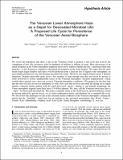The Venusian Lower Atmosphere Haze as a Depot for Desiccated Microbial Life: A Proposed Life Cycle for Persistence of the Venusian Aerial Biosphere
Author(s)
Seager, Sara; Petkowski, Janusz J; Gao, Peter; Bains, William; Bryan, Noelle C; Ranjan, Sukrit; Greaves, Jane; ... Show more Show less
DownloadPublished version (1.005Mb)
Publisher with Creative Commons License
Publisher with Creative Commons License
Creative Commons Attribution
Terms of use
Metadata
Show full item recordAbstract
We revisit the hypothesis that there is life in the Venusian clouds to
propose a life cycle that resolves the conundrum of how life can persist aloft
for hundreds of millions to billions of years. Most discussions of an aerial
biosphere in the Venus atmosphere temperate layers never address whether the
life-small microbial-type particles-is free floating or confined to the liquid
environment inside cloud droplets. We argue that life must reside inside liquid
droplets such that it will be protected from a fatal net loss of liquid to the
atmosphere, an unavoidable problem for any free-floating microbial life forms.
However, the droplet habitat poses a lifetime limitation: Droplets inexorably
grow (over a few months) to large enough sizes that are forced by gravity to
settle downward to hotter, uninhabitable layers of the Venusian atmosphere.
(Droplet fragmentation-which would reduce particle size-does not occur in
Venusian atmosphere conditions.) We propose for the first time that the only
way life can survive indefinitely is with a life cycle that involves microbial
life drying out as liquid droplets evaporate during settling, with the small
desiccated 'spores' halting at, and partially populating, the Venus atmosphere
stagnant lower haze layer (33-48 km altitude). We, thus, call the Venusian
lower haze layer a 'depot' for desiccated microbial life. The spores eventually
return to the cloud layer by upward diffusion caused by mixing induced by
gravity waves, act as cloud condensation nuclei, and rehydrate for a continued
life cycle. We also review the challenges for life in the extremely harsh
conditions of the Venusian atmosphere, refuting the notion that the 'habitable'
cloud layer has an analogy in any terrestrial environment.
Date issued
2020Department
Massachusetts Institute of Technology. Department of Earth, Atmospheric, and Planetary Sciences; Massachusetts Institute of Technology. Department of Physics; Massachusetts Institute of Technology. Department of Aeronautics and AstronauticsJournal
Astrobiology
Publisher
Mary Ann Liebert Inc